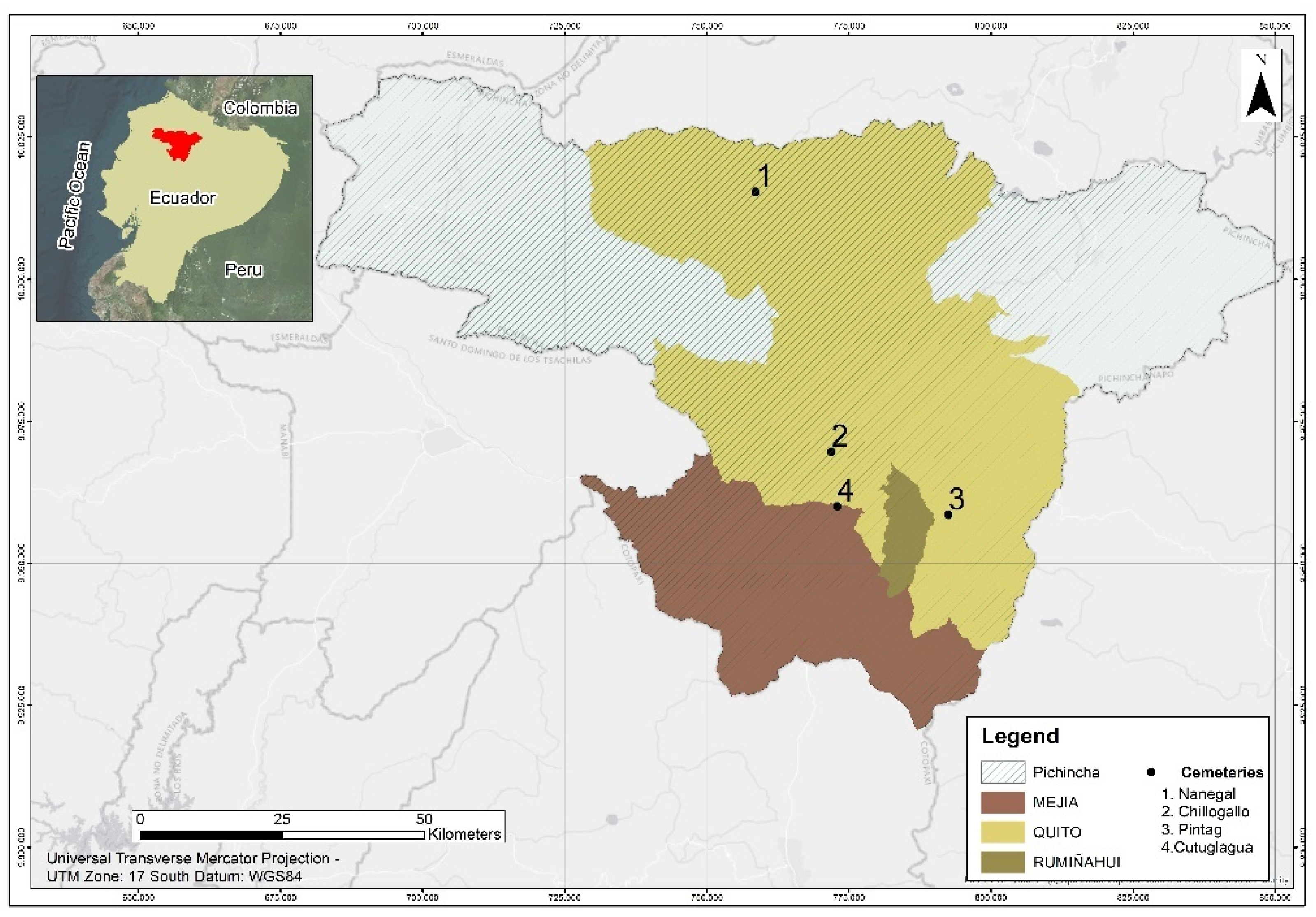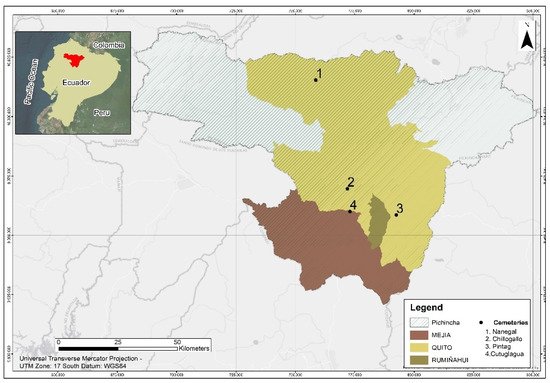Cemeteries are sites for the final disposal of human bodies that constitute a source of contamination of soil and water as a result of the cadaveric decomposition generated. In addition, land use conflicts were encountered in the cemetery grounds. It is concluded that the existing cemeteries should be subjected to more detailed environmental analysis and subsequently should be treated as security landfills in the closure and post-closure stage. Also, it has been concluded that the cemeteries should not be located in urban or peri-urban areas.
- cemeteries
- polluted environment
- cadaveric decomposition
- Ecuador
1. Introduction
2. The Local Case of Ecuador
Of the 72 cemeteries located in Central Ecuador, 32 were identified as poorly located as the result of a spatial analysis [48][29]. Hydrography criteria, soil texture, population density, slope, green areas, distance to the historic center, precipitation and temperature were introduced in a subsequent analysis, determining that there is a possibility of environmental contamination due to the equivocal location of nine cemeteries [46][30]. In the latter, classified as potentially polluting, a field study was performed that included determination of the water table, biochemical oxygen demand (BOD), chemical oxygen demand (COD), dissolved oxygen (DO), electrical conductivity, pH and temperature, furthermore, to the addition of variables such as distance to the body of water, type of soil, number of graves, age of the cemetery and geological fault. Therefore, it was concluded that the potential that these nine (9) graveyards are very likely sources of environmental contamination, they also lacked any completely adequate areas for the location of cemeteries [11].
3. Study Area
The study area focused on the cemeteries located in the central highlands of Ecuador, within the province of Pichincha. This area was selected as it is adjacent to Quito, the capital of the Republic of Ecuador, which has the second highest population density in the country [52][31]. There have been four specific cemeteries within three different cantons, which are particularly the cemeteries of: 1. Nanegal; 2. Chillogallo; 3. Pintag; and 4. Cutuglagua (Figure 1).

 Figure 1. Inlet illustrates position of study area within Ecuador and main map locates the studied cemeteries as indicated in the corresponding legend.
Figure 1. Inlet illustrates position of study area within Ecuador and main map locates the studied cemeteries as indicated in the corresponding legend.4. Research Findings
5. Conclusions
References
- Velasco Rivera, A.; Minota Zea, Y.M. Evaluación por contaminación en suelos aledaños a los cementerios Jardines del Recuerdo e Inmaculada. Cienc. E Ing. Neogranadina 2012, 22, 165.
- Zychowski, J. Impact of cemeteries on groundwater chemistry: A review. Catena 2012, 93, 29–37.
- Planteamientos y acciones en materia de higiene pública: Los cementerios de la ciudad de México a principios del siglo diecinueve. Rev. Cult. Y Reli. 2008, 2, 60–81. Available online: https://revistaculturayreligion.cl/index.php/revistaculturayreligion/article/view/182/1712 (accessed on 21 October 2021).
- Hugo, G. Future demographic change and its interactions with migration and climate change. Glob. Environ. Chang. 2011, 21 (Suppl. 1), S21–S33.
- McDonald, R.I.; Marcotullio, P.J.; Güneralp, B. Urbanization and global trends in biodiversity and ecosystem services. In Urbanization, Biodiversity and Ecosystem Services: Challenges and Opportunities: A Global Assessment; Springer Nature: Basingstoke, UK, 2013; pp. 31–52. ISBN 9789400770881.
- Allén, A. La interfase periurbana como escenario de cambio y acción hacia la sustentabilidad del desarrollo. Cuad. CENDES 2003, 20, 7–21. Available online: http://ve.scielo.org/scielo.php?pid=S1012-25082003000200002&script=sci_arttext (accessed on 4 November 2021).
- Canning, L.; Szmigin, I. Death and disposal: The universal, environmental dilemma. J. Mark. Manag. 2010, 26, 1129–1142.
- Nguyen, T.; Nguyen, L. Groundwater pollution by longstanding cemetery and solutions for urban cemetery planning in Ho Chi Minh City—From reality to solutions. In MATEC Web of Conferences; EDP Sciences: Les Ulis, France, 2018; Volume 193, p. 02008.
- Scalenghe, R.; Pantani, O.L. Connecting existing cemeteries saving good soils (for livings). Sustainability 2020, 12, 93.
- da Cruz, N.J.T.; Lezana, Á.G.R.; Freire dos Santos, P.D.C.; Santana Pinto, I.M.B.; Zancan, C.; Silva de Souza, G.H. Environmental impacts caused by cemeteries and crematoria, new funeral technologies, and preferences of the Northeastern and Southern Brazilian population as for the funeral process. Environ. Sci. Pollut. Res. 2017, 24, 24121–24134.
- Guayasamín Vergara, J.D. Establecimiento De Índices Empíricos Ambientales Para Manejo De Cadáveres Humanos: Entierro Y Cremación En Ecuador. Master’s Thesis, Universidad de las Fuerzas Armadas ESPE, Sangolquí, Ecuador, 2021.
- Niţǎ, M.R.; Iojǎ, I.C.; Rozylowicz, L.; Onose, D.A.; Tudor, A.C. Land use consequences of the evolution of cemeteries in the Bucharest Metropolitan Area. J. Environ. Plan. Manag. 2014, 57, 1066–1082.
- Nguyen, X.L.; Chou, T.Y.; Hoang, T.V.; Fang, Y.M.; Nguyen, Q.H. Research on Optimal Cemetery Location Selection using Approach of Fuzzy Set Theory and Analytic Hierarchy Process in Environment of Geographic Information System: A Case Study in Hung Ha District, pages 1–9 Thai Binh province, Vietnam. Int. J. Res. Innov. Earth Sci. 2019, 6, 20–28.
- Baden, B.M.; Coursey, D.L. The locality of waste sites within the city of Chicago: A demographic, social, and economic analysis. Resour. Energy Econ. 2002, 24, 53–93.
- Neckel, A.; Korcelski, C.; Kujawa, H.A.; Schaefer da Silva, I.; Prezoto, F.; Walker Amorin, A.L.; Maculan, L.S.; Gonçalves, A.C.; Bodah, E.T.; Bodah, B.W.; et al. Hazardous elements in the soil of urban cemeteries; constructive solutions aimed at sustainability. Chemosphere 2021, 262, 128248.
- Tudor, C.A.; Iojǎ, I.C.; Hersperger, A.; Pǎtru-Stupariu, I. Is the residential land use incompatible with cemeteries location? Assessing the attitudes of urban residents. Carpathian J. Earth Environ. Sci. 2013, 8, 153–162.
- Schneider, A.; Mertes, C.M.; Tatem, A.J.; Tan, B.; Sulla-Menashe, D.; Graves, S.J.; Patel, N.N.; Horton, J.A.; Gaughan, A.E.; Rollo, J.T.; et al. A new urban landscape in East-Southeast Asia, 2000–2010. Environ. Res. Lett. 2015, 10, 034002.
- Fistola, R. The unsustainable city. Urban entropy and social capital: The needing of a new urban planning. Procedia Eng. 2011, 21, 976–984.
- Peluso, F.; Vives, L.; Varni, M.; Cazenave, G.; González Castelain, J.; Usunoff, E. Evaluación preventiva espacial del riesgo sanitario por la instalación de un cementerio parque. GeoFocus. Rev. Int. De Cienc. Y Tecnol. De La Inf. Geográfica 2006, 6, 1–14.
- Fiedler, S.; Graw, M. Decomposition of buried corpses, with special reference to the formation of adipocere. Naturwissenschaften 2003, 90, 291–300.
- Rodriguez, W.C.; Bass, W.M. Decomposition of Buried Bodies and Methods That May Aid in Their Location. J. Forensic Sci. 1985, 30, 11017J.
- Casper, J.L.; William Balfour, G. A Handbook of the Practice of Forensic Medicine, Based upon Personal Experience; Balfour, G.W., Translator; New Sydenham Society: London, UK, 1989; Volume 1, pp. 36–45. ISBN 1376611694.
- Carter, D.O.; Yellowlees, D.; Tibbett, M. Moisture can be the dominant environmental parameter governing cadaver decomposition in soil. Forensic Sci. Int. 2010, 200, 60–66.
- Mego Julca, G. Descomposición Cadavérica y Determinación del Intervalo Post-Mortem. Skopein 2016, 12, 5. Available online: https://dialnet.unirioja.es/servlet/articulo?codigo=5559749&info=resumen&idioma=SPA12,5 (accessed on 25 October 2021).
- Schroeder, H.; Klotzbach, H.; Oesterhelweg, L.; Püschel, K. Larder beetles (Coleoptera, Dermestidae) as an accelerating factor for decomposition of a human corpse. Forensic Sci. Int. 2002, 127, 231–236.
- Neckel, A.; Costa, C.; Mario, D.N.; Sabadin, C.E.S.; Bodah, E.T. Environmental damage and public health threat caused by cemeteries: A proposal of ideal cemeteries for the growing urban sprawl. Urbe 2017, 9, 216–230.
- Scottish Environment Protection Agency Land Use Planning System SEPA Guidance Note Guidance on Assessing the Impacts of Cemeteries on Groundwater Uncontrolled Document When Printed Out. 2015. Available online: http://map.sepa.org.uk/floodmap/map.htm (accessed on 9 April 2021).
- Aroha, M.; Michele, W. Cemetery Setback Distance To Prevent Surface Water Contamination. Natl. Collab. Cent. Environ. Health 2017, 2–7. Available online: https://ncceh.ca/sites/default/files/Cemetery_setback_distances_surface_water_contamination-Oct_2017.pdf (accessed on 25 October 2021).
- Arcos Yánez, E.S. Identificación De Zonas Ambientalmente No Adecuadas Para La Ubicación De Camposantos En Los Cantones Mejía, Quito y Rumiñahui; Universidad de las Fuerzas Armdas “ESPE”: Sangolquí, Ecuador, 2020.
- Ministerio de Salud Pública del Ecuador. Reglamento Para Regular El Funcionamiento De Los Establecimientos Que Prestan Servicios Funerarios Y De Manejo De Cadáveres Y Restos Humanos; Estado de Ecuador: Quito, Ecuador, 2013; pp. 1–15.
- Quitocómovamos Información Sobre Demografía Quito Como Vamos 2020 Demografía Crecimiento Poblacional Y Expansión Rural Densidad Poblacional Población Por Sexo Y Edad. Available online: https://quitocomovamos.org/wp-content/uploads/2021/05/1.DEMOGRAFÍA.pdf (accessed on 28 December 2021).
- Jones, D.L.; Williamson, K.L.; Owen, A.G. Phytoremediation of landfill leachate. Waste Manag. 2006, 26, 825–837.
- Seo, B.H.; Kim, H.S.; Kuppusamy, S.; Kim, K.H.; Kim, K.R. Enhanced nitrogen and phosphorus removal by woody plants with deep-planting technique for the potential environmental management of carcass burial sites. Sustainability 2017, 9, 155.
- Yoon, J.H.; Kim, Y.N.; Shin, D.C.; Kim, K.R.; Kim, K.H. Management of animal carcass disposal sites using a biochar permeable reactive barrier and fast growth tree (populus euramericana): A field study in Korea. Sustainability 2017, 9, 457.
- Autie, J.; Saanie, T.; Telppanen, P. Assessment of Alternative Disposal Concepts; U.S. Department of Energy Office of Scientific and Technical Information: Washington, DC, USA, 1996; Volume 30, ISBN 9516520111.
- Amaya, L.G.d.C.; Marcel, S.N.; Susana, L. Cierre, sellado y reinserción de antiguos vertederos. experiencias en iberoamérica. Rev. Int. Contam. Ambient. 2016, 32, 123–139.
- Lara Galindo, E.; Zulaica, L.; Flores Domínguez, Á.D. Aportes Conceptuales Y Metodológicos Para La Definición Y Análisis Del Periurbano De La Ciudad De Puebla, México. Rev. Estud. Marítimos Y Soc. 2019, 14, 12–34. Available online: https://ri.conicet.gov.ar/handle/11336/121513 (accessed on 25 November 2021).
- Aruomero, A.S.; Afolabi, O. Comparative assessment of trace metals in soils associated with casket burials: Towards implementing green burials. EJSS 2014, 3, 65.
- Yarwood, R.; Sidaway, J.D.; Kelly, C.; Stillwell, S. Sustainable deathstyles? The geography of green burials in Britain. Geogr. J. 2015, 181, 172–184.
- Hart, A. Circular economy: Closing the catalyst loop with metal reclamation from spent catalysts, industrial waste, waste shells and animal bones. Biomass Convers. Biorefinery 2021, 1–16.
